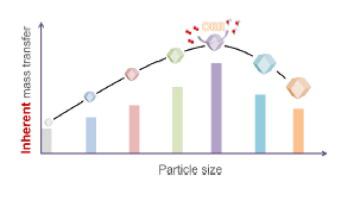Journal of Energy Chemistry ( IF 14.0 ) Pub Date : 2020-11-01 , DOI: 10.1016/j.jechem.2020.10.028 Yanzhi Wang , Bin Wang , Haitao Yuan , Zuozhong Liang , Zhehao Huang , Yuye Zhou , Wei Zhang , Haoquan Zheng , Rui Cao

|
Current concerns on material-design induced mass transfer processes during small molecule electrocatalysis are on the ones assisted by external forced convection generally via electrode rotating, demonstrating the intrinsic activity of catalysts. Of note is that, in practical battery configurations there is no the forced convection around electrode micro-environments. Therefore, the establishment of effective strategies in tuning the inherent mass transfer process, the one with no assistance by external forced convection, is also greatly significant, but rarely reported, retarding further advances. Herein, a size-induced inherent mass-transfer strategy is scrupulously established through designed kinetic investigations and also controllable construction of uniform Co, N co-doped carbon materials with a wide range of tunable particle sizes from 10 nm to 2 μm. The catalysts are synthesized by a pyrolysis of zeolitic imidazolate framework (ZIF) 67@ZIF-8, in which the wrapped shell layer avoids evident metal aggregations, and also contributes to rich porous environments after carbonizations. It is unclosed that particle size has a considerable effect on inherent mass transfer processes, even for the porous carbon catalysts. A particle size at around 700 nm is revealed to be most favorable for the inherent mass transfer process within the probed range, revealed by the smallest difference of Tafel slopes obtained with no electrode rotation and with infinite rotation speed. The latter is achieved via extrapolating rotation speeds to infinity in the Koutecký-Levich plots, by which the external mass transfer limitation can be completely eliminated. Contributed by the great inherent mass transfer process, the catalyst with a particle size of around 700 nm exhibits an impressive ORR activity in both three-electrode systems and zinc-air batteries. This work not only establishes a novel strategy in tuning inherent mass transfer process for small molecule electrocatalysis, more importantly, it provides a new dimension in kinetic investigations and oriented design of advanced energy materials.
中文翻译:

Co,N共掺杂碳材料对氧还原反应的固有传质工程
在小分子电催化过程中,材料设计引起的传质过程的当前关注点通常是通过电极旋转通过外部强制对流来辅助的,这证明了催化剂的固有活性。值得注意的是,在实际的电池配置中,电极微环境周围没有强制对流。因此,建立有效的策略来调节固有的传质过程,即在没有外部强制对流的情况下进行辅助的策略,也具有重大意义,但鲜有报道,阻碍了进一步的发展。在此,通过设计的动力学研究以及均匀Co的可控结构,严格建立了尺寸诱导的固有传质策略。N个共掺杂碳材料,其可调颗粒尺寸范围从10 nm到2μm。该催化剂是通过热分解沸石咪唑酸酯骨架(ZIF)67 @ ZIF-8合成的,其中包裹的壳层避免了明显的金属聚集,并且在碳化后还有助于形成丰富的多孔环境。尚未公开的是,即使对于多孔碳催化剂,粒径对固有的传质过程也具有相当大的影响。揭示了在700 nm左右的粒径最有利于探测范围内的固有传质过程,这是由没有电极旋转且旋转速度无限的Tafel斜率的最小差异所揭示的。后者是通过将旋转速度外推到Koutecký-Levich图中的无穷大来实现的,从而可以完全消除外部传质限制。归因于巨大的固有质量传递过程,粒径约为700 nm的催化剂在三电极系统和锌空气电池中均表现出令人印象深刻的ORR活性。这项工作不仅为调节小分子电催化的固有传质过程建立了新的策略,而且更重要的是,它为动力学研究和先进能源材料的定向设计提供了新的方向。











































 京公网安备 11010802027423号
京公网安备 11010802027423号